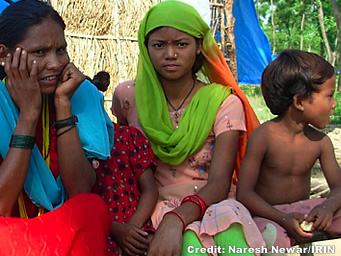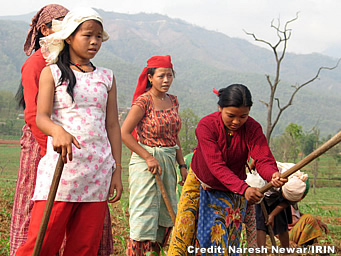 |
| Social Status of Women |
|
|
|
|
 |
|
 |
| Rescuing girls from slave-like servitude |
KATHMANDU, 4 June 2010 (IRIN)
| Thousands of Tharu girls have been sold into servitude |
 |
|
She survived extreme inhumanity at the hands of her owners in Kathmandu," said Manoj Silwal, programme director of the Nepalese Youth Opportunity Foundation (NYOF), an international organization working with FNC.
The practice of selling daughters for indentured servitude - "kamlari" - is done through a middleman, traditionally in western Nepal's indigenous Tharu community.
Thousands of kamlari girls around Nepal have suffered starvation, rape and other forms of sexual abuse, being burnt and stabbed by their "owners", according to investigations by NYOF.

|
Education funding
Raju Dhamala, executive director of FNC, told IRIN that Nepal's kamlari girls are "safer now as most of them have been rescued, and the parents who were unaware of such abuses are no longer practising this tradition".
Since 2000, the two NGOs have rescued close to 10,000 kamlaris, though estimates suggest there are 20,000 around the country. Almost 7,000 were younger than 14, and some as young as eight, all working for middle-class and elite families in urban areas. This year, 3,595 girls have been rescued, and the organizations have sent warnings to the households holding the remaining 1,000 kamlaris.
Shardha Chaudhary barely survived the ordeal
Both FNC and NYOF claim the government fails to support the rehabilitation of rescued girls although government officials say funding has been made available and it is taking steps to be more actively involved in the process.
So far, $1.5 million has been allocated for educational support, but it is barely enough to meet the needs of the rescued girls.
"The government has to address the root problems and educational support covers only the tip of the iceberg," said Dhamala.
Poverty pressure
With many Nepalese families landless, jobless and hungry, opportunities to make a little extra cash are few and far between, while almost one-third of the country's 28 million people live below the poverty line on less than $1 a day.
Dhamala said that only the Ministry of Education was involved in the rehabilitation, and the government should mobilize other ministries and come up with a far-reaching economic programme.
"Unless the families get more humanitarian aid and poverty-alleviation support, the risks of the kamlari system resuming are always there," said Silwal from NYOF.
The government gives reunited families $25 a year towards the education of rescued kamlari girls, but this barely covers school expenses, according to NYOF.
"For the time being, they are not sending off their daughters to work as kamlaris due to social pressure, but for how long they will do that is our concern as most have lost their financial support and were dependent on their children to meet even their basic needs," said Silwal.
Shanta Chaudhary, 28, a lawmaker who was herself a kamlari at 10, urged the government "to keep its promises to provide humanitarian assistance as part of their rehabilitation, and take measures to protect them from further risks".
| Menstruating girls miss out on school |
KATHMANDU, 2 May 2010 (IRIN)
 |
|
To address this issue, better sanitation management in schools - particularly in rural and semi-urban environments - is needed, Tuladhar stressed.
Poor sanitation is linked to a lack of gender sensitivity, the UNICEF officer noted, with most schools continuing to neglect the special needs of adolescent girls.
Many girls are missing out on between 10 and 20 percent of all class days, she said.
Girls prefer to stay home
According to a 2009 survey by Water Aid, an international NGO, the key reasons girls were absent while menstruating was a lack of privacy, unavailability of sanitary disposal facilities and water shortages.
"Although several public schools, even in rural areas, now have separate toilets for female students, they are poorly managed," said Susan Acharya, an education expert at the Tribhuwan University, the country's largest.
Acharya, who has conducted several studies on girls' education, says most rural schools have no water taps, although the reason is more cultural than financial.
"Our sanitation system is strongly linked to culture. Schools are regarded as temples so you will not find toilets attached to schools," she explained.
And with taps installed far from the toilets, girls have no choice but to carry whatever water is needed to clean themselves back and forth, all under the gaze of their fellow classmates.
Many girls would rather stay at home than attend school
Most public schools in Nepal are co-ed and girls are often harassed by their male counterparts.
"To avoid humiliation - especially teasing by school boys - they [the girls] would rather go home. This is one of the reasons why they lose interest in going to school," Acharya noted.
In rural areas, girls cannot afford sanitary pads or tampons and instead use rags, which if not properly cleaned can result in infections.
An opposing view
However, a new study by the Menstruation and Education in Nepal Project, supported by the University of Michigan, University of Chicago and Harvard University, concluded that menstruation had very little impact on school attendance.
Based on research in four schools in Chitwan District, nearly 300km west of the capital, only a total of 0.4 days in a 180-day school year was missed.
"Claims that menstruation is a barrier to schooling are overstated and modern sanitary products are unlikely to affect educational attainment," the report said.
That assertion has been criticized by some Nepali experts, noting that Chitwan was one of the country's most developed urban areas.
"Such a claim can only undermine the much-needed menstrual hygiene and management to be introduced in schools by the government and integrated in the overall hygiene intervention," one expert, who asked not to be identified, said.
This is supported by UNICEF's 2009, Equity in School Water and Sanitation report.
"In most schools, it was reported that girls took leave from school if they menstruated," it read.
"When we talk about girls' education, we cannot only focus on scholarships or building toilets. We need an integrated approach that involves gender sensitivity among teachers and the need to educate the mothers also on the issue of menstrual impact on girls," said Manju Khadka, a women's empowerment officer from a local NGO, Educate the Children.
Such awareness was needed not just for male teachers, but school management committees and parents as well, she said.
| Source:IRIN 2010 Copyright Ⓒ UN Office for the Coordination of Humanitarian Affairs 2007 [ This report does not necessarily reflect the views of the United Nations] Integrated Regional Information Networks (IRIN), part of the UN Office for the Coordination of Humanitarian Affairs (OCHA). |
| External Links |
|
|
|
||
| IRIN News |
| more information |
| External Links |
|
| Links |
| External Links |
|
|
|